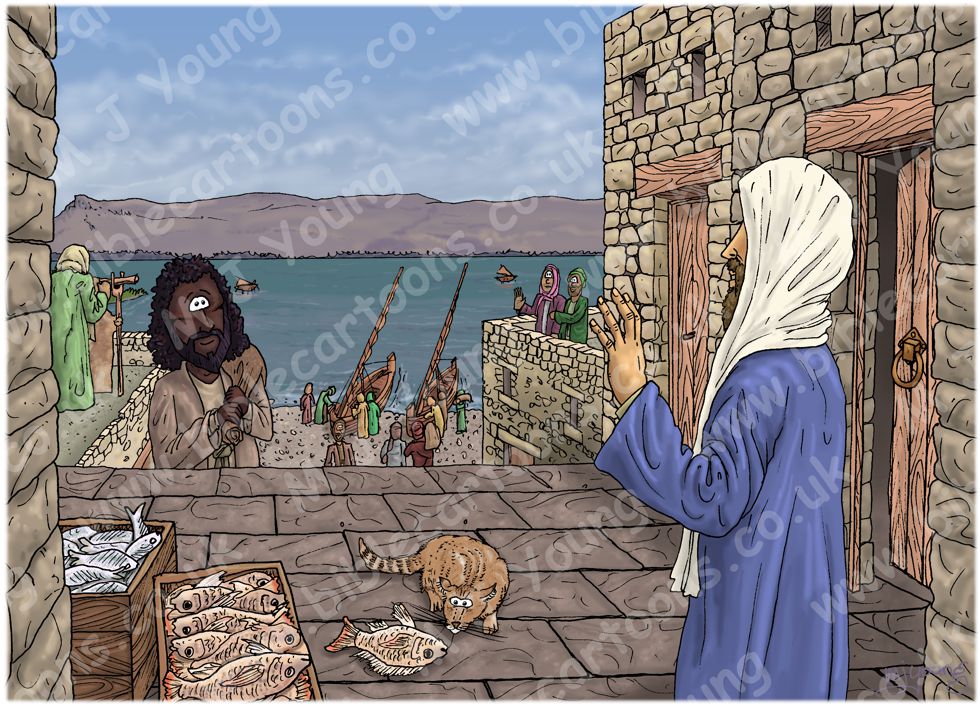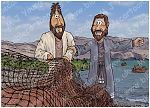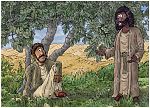Bible Cartoon: John 01 - Jesus' first disciples - Scene 03 - Follow me Philip
Click on Add to cart button below shopping cart.
Purchased Bible Cartoons do not have watermarks. Links to Cartoons provided on email once purchase is completed.Bible Book: John
Bible Book Code: 4300104301
Scene no: 3 of 5
Bible Reference & Cartoon Description
John 1:43-44 (ANIV)
Jesus Calls Philip and Nathanael
43 The next day Jesus decided to leave for Galilee. Finding Philip, he said to him, “Follow me.”
44 Philip, like Andrew and Peter, was from the town of Bethsaida.
DRAWING NOTES:
TIME OF DAY:
Unspecified in the Bible narrative. I have set this scene in the early afternoon.
LIGHTING NOTES:
The sun (high up & on the right (in the west) illuminates this scene, casting shadows to the left (towards the east) & below figures & objects.
CHARACTERS PRESENT:
In the foreground, from left to right: Philip, Jesus the Christ.
Various Hebrew people on top of houses, or by the shore.
A cat in the foreground, with boxes of fish.
RESEARCH/ADDITIONAL NOTES:
The Bible doesn’t tell us where Jesus first encountered Philip. I have set this scene in the town of Bethsaida, which was on the North Eastern shore of the Sea of Galilee. We are looking out from the town, South East, towards the Sea of Galilee, with hills behind the far shore.
The Bible doesn’t tell us what occupation Philip had, before becoming a disciple & apostle of Jesus the Christ. Since he was from Bethsaida, some scholars believe he may have been a fisherman, like Andrew, Simon/Peter, et al. In my scene I have drawn Philip climbing some steps in the town (that’s why we can only see the upper half of his body), with a sack over his shoulders…who knows what is in the sack!
The Philip mentioned here in John chp 1 was a disciple (later apostle) of Jesus, but must not be confused with Philip the deacon (see Acts 6:5).
Here is the scene without the figures.

Background of John 01 – Jesus’ first disciples – Scene 03 – Follow me Philip
Click on the colour bar below to view/buy this Background:
Background of John 01 – Jesus’ first disciples – Scene 03 – Follow me Philip
“Though the first disciples were from Galilee, Jesus had called them in Judea where they were with John the Baptist. On His way north to Galilee, He called Philip to be His disciple. Philip’s hometown of Bethsaida was on the northeast side of the Sea of Galilee (called “Bethsaida in Galilee” in John 12:21). Also Andrew and Peter were born there. Politically, Bethsaida was in lower Gaulonitis in the territory of Herod Philip (Josephus The Antiquities of the Jews 18. 2. 1). Philip’s name is Greek but his nationality cannot be inferred from that fact.”
[Source: Bible Knowledge Commentary]
“Some radical Greek teachers were said to have called disciples to follow them (e.g., Socrates called Xenophon), but normally ancient students or their parents chose their own teachers. As often in Matthew and John, “following” could mean “becoming a disciple,” because disciples could show respect to masters of Torah (law) by walking behind them. In the Fourth Gospel, however, this term also has greater significance (see John 10:4).
Bethsaida was known for its fishing industry. Mark says that Simon and Andrew were from Capernaum (John 1:21, 29; John 2:1), and excavations confirm that early Christians thought that Peter’s home was there. It is not unlikely that as fishermen in a fishing cooperative with James and John (Mark 1:19) they took their boats back and forth between Capernaum and Bethsaida.”
[Source: Bible Background Commentary]
St.Peter’s Fish
The fish in the wooden box on the right is Sarotherodon galilaeus (aka The mango tilapia; other common names include Galilaea tilapia, Galilean comb, Galilee St. Peter’s fish, and St. Peter’s fish). It is a species of fish from the cichlid family that is native to fresh and brackish waters in Africa and the Levant. (To differentiate from other Israeli species of “St. Peter’s fish” see below.) This is a relatively large cichlid at up to 16 inches (41 cm) in total length and about 3.5 pounds (1.6 kilograms) in weight. It is very important to local fisheries and the species is also aquacultured.
In addition to the nominate subspecies, four subspecies were recognized in the past, but today the species is considered monotypic.
This widespread species is found in lakes, rivers and other fresh or brackish habitats in northern and central Africa (including Saharan oases), ranging as far south as the Guinea region, the Congo River Basin, Lake Albert and Lake Turkana. Outside Africa it is found in Syria, Jordan and Israel. It is one of the very few cichlids that is found in Africa north of the Sahara and in Asia. The typical temperature range is 22–28 °C (72–82 °F), but it has been recorded from waters as cold as 9 °C (48 °F).
[Source: https://en.wikipedia.org/wiki/Mango_tilapia]





